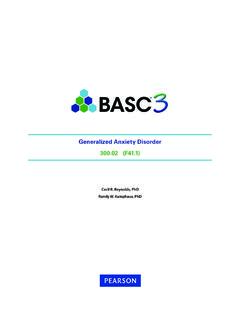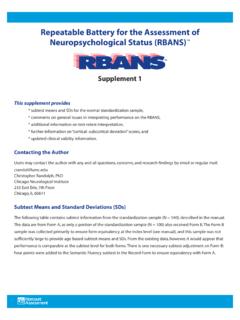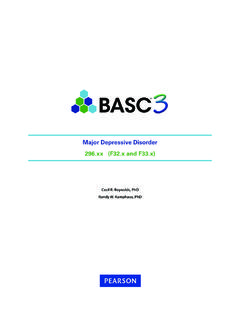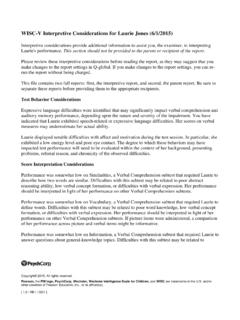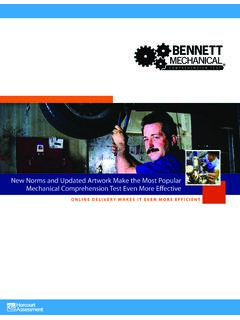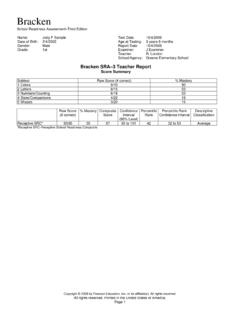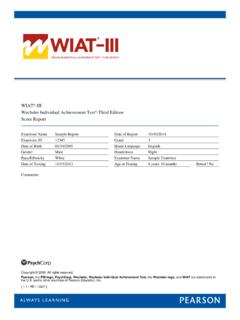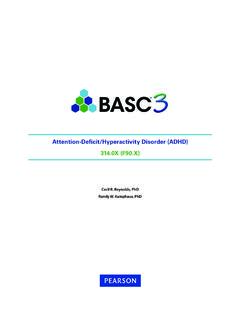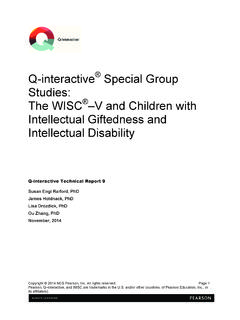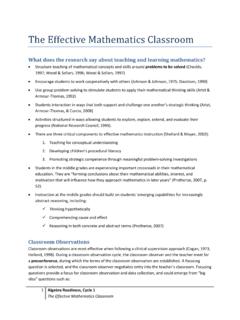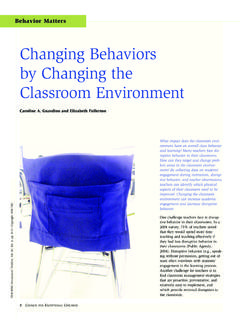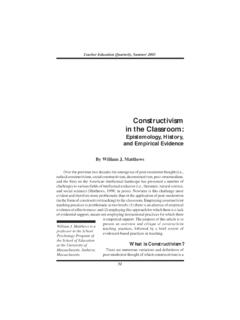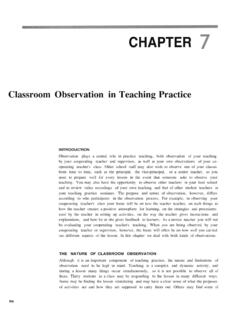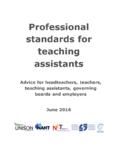Transcription of Conducting Systematic Behavioral Observations in Schools ...
1 Conducting Systematic Behavioral Observations in Schools : Using the Behavioral observation of Students in Schools (BOSS). App for iPhone and Android Edward S. Shapiro, Center for Promoting Research to Practice, Lehigh University Bethlehem, Pennsylvania AGENDA. Brief Overview of Systematic observation In Depth Overview of the Behavioral observation of Students in Schools (BOSS). Using the iPhone and Android APPS for the BOSS. Interpretation of BOSS data 2. Overview of Systematic observation Important Reasons for Conducting Systematic observation Quantitative data collection Systematically confirmation (or disconfirmation) of teacher subjective judgment Determine actual severity of the reported problem Provide a baseline against which to assess the success/failure of instructional intervention Provides feedback to stakeholders ( , caregivers, students, teachers, etc.)
2 Regarding the types and levels of problems students are currently having 4. What Can Be Learned from Systematic observation for Academic Assessment? Academic engagement Opportunity to learn Active teaching/learning Teacher directed instruction Rate of accurate student response Demonstrate/prompt/practice 5. Identifying the Behaviors for observation Carefully & precisely define behaviors For academics what matters Levels of academic engagement Type of engagement Type of non-engagement 6. Keys to Good Observations Accurately represents the child's behavior at the time of the observation & at other times of the day Situation in which behaviors was observed represent where the problems tend to occur Always ask teacher whether the behavior seen that day was typical for the student 7. How much observation is needed?
3 It depends Good Rule of Thumb: 3 Observations Accurate Observations require at least 10-15. minutes Optimally Observations should be: 20-30 minutes Observations should be repeated over 2-3 days Across different types of academic settings ( , ISW in reading, small-group in math, large-group in science, etc.) 8. Before Observing in the Classroom Contact the teacher to arrange the best time to observe the student Familiarize yourself with the daily schedule, routine, &. physical layout of the classroom Clear view of student, but not obtrusive Meet briefly with teacher to learn about classroom rules or procedures that may be in effect during the observation Observer should minimize any interactions with students or the teacher during the observation period 9. Behavioral observation of Students in Schools (BOSS).
4 BOSS App Simple and flexible Recording device/Data storage system Timing device Cueing device Data analysis system Some customization possible by user Reports (pdf and csv files) output via email 11. Key Features of the BOSS. Designed for Pre-K through 12th grade Systematic recording of direct Observations of children's behavior in the academic environment Observe key behaviors related to academic skill development Subdivide on-task behavior into active and passive categories Subdivide off-task behavior into motor, verbal, & passive categories Collect local normative comparison data ( , peer comparison) for accurate interpretations 12. SETTING UP A NEW SESSION. ( observation ). iPhone Android 13. SETTING UP A NEW SESSION. ( observation ). iPhone Android 14. Key Information Observer name, Student name, School, Grade Task (Subject).
5 Language Arts, Mathematics, Reading, Writing Option to add user defined task or subject Science? Social Studies? Guided Reading Groups? Cooperative Groups? 15. Key Information - Setting ISW:TPsnt . Student = Individual Seatwork: Teacher Present ISW:TSmGp Student = Individual Seatwork: Teacher working with the group SmGP:TPsnt Student = small group (<10): Teacher working with group LgGp:TPsnt Student = large group (10+): Teacher working with large group 16. Other User defined Entering User Defined Field (iPhone illustrated). 17. Key Information Duration Interval 18. BOSS observation Codes (Template = Default). On-task behavior subdivided: Actively Engaged Time (AET). Passively Engaged Time (PET). Off-task behavior subdivided: Off-Task Motor (OFT-M). Off-Task Verbal (OFT-V). Off-Task Passive (OFT-P).
6 Teacher Directed Instruction (TDI) 19. Active Engaged Time (AET). AET is defined as those times when the student is actively attending to the assigned work Examples: Writing Reading aloud Raising a hand to answer a teacher's question Talking to the teacher about the assigned material Talk to a peer about the assigned material Looking up a word in a dictionary Typing essay on computer AET should not be scored if the student is: Talking about nonacademic materials (OFT-V). Walking to the worksheet bin (OFT-M). Calling out (OFT-V) Unless it is considered an appropriate response style for the classroom Aimlessly flipping the pages of a book (OFT-M). Any other form of off-task behavior 20. Passive Engaged Time (PET). PET is defined as those times when the student is passively attending to the assigned work At times it may be difficult to determine immediately whether the child is passively engaged or daydreaming (OFT-P) at the 1st moment of an interval If it becomes apparent within 3 seconds after the start of the interval that the students was OFT-P or PET you can change your response Examples: Listening to a lecture Looking at an academic worksheet Reading assigned material silently Looking at the blackboard during teacher instruction Listening to a peer respond to a question PET should not be scored if the student is: Aimlessly looking around the classroom (OFT-P).
7 Silently reading unassigned material (OFT-P) 21. Any other form of off-task behavior OFF-Task Motor (OFT-M). OFT-M behaviors are defined as any instance of motor activity that is not directly associated with an assigned academic task Examples: Engaging in any out-of-seat behavior (defined as buttocks not in contact with seat). Aimlessly flipping the pages of a book Manipulating objects not related to the academic task ( , playing with a paper clip, throwing paper, twirling a pencil, & folding paper). Physically touching another student when not related to an academic task Bending or reaching ( , picking up a pencil off the floor). Drawing or writing that is not related to an assigned academic activity Turning around in one's seat, oriented away from the classroom instruction Fidgeting in one's seat ( , engaging in repetitive motor movements for at least 3.)
8 Consecutive seconds; student must be off-task for this category to be scored). OFT-M should not be scored if the student is: Passing paper to a student, as instructed by the teacher (AET). Coloring on an assigned worksheet as instructed by the teacher (AET). Laughing at a joke told by another student (OFT-V). Swinging feet while working on assigned material (AET or PET) 22. OFF-Task Verbal (OFT-V). OFT-V behaviors are defined as any audible verbalizations that are not permitted and/or are not related to an assigned academic task Examples: Making any audible sound, such as whistling, humming, forced burping Talking to another student about issues unrelated to an assigned academic task Talking to another student about an assigned academic task when such talk is prohibited by the teacher Making unauthorized comments or remarks Calling out answers to academic problems when the teacher has not specifically asked for an answer or permitted such behavior OFT-V should not be scored if the student is: Laughing at a joke told by the teacher Talking to another student about the assigned academic work during a cooperative learning group (AET).
9 Calling out the answer to a problem when the teacher has permitted such 23. behavior during instruction (AET). OFF-Task Passive (OFT-P). OFT-P behaviors are defined as those times when a student is passively not attending to an assigned academic activity for a period of at least 3. consecutive seconds within an interval If the interval ends before the 3 consecutive seconds, OFT-P is not scored for that interval The Count starts over a new 3 consecutive seconds is needed to score OFT-P in the new interval Examples: Student is quietly waiting after the completion of an assigned task but is not engaged in an activity authorized by the teacher Sitting quietly in an unassigned activity Looking around the room Starring out the window Passively listening to other students talk about issues unrelated to the assigned academic activity OFT-P should not be scored if the student is: Quietly reading an assigned book (PET).
10 Passively listening to other students talk about the assigned work in a cooperative learning group (PET) 24. Teacher-Directed Instruction (TDI). TDI is defined as those times when the teacher is directly instructing the class or individuals within the class Provides a sampling of time in which the teacher is actively engaged in direct instruction of the classroom Examples: Instructing the whole class or group Demonstrating academic material at the board Individually assisting a student with an assigned task TDI should not be scored if the teacher is: Scolding/Reprimanding the class or an individual student for misbehavior Giving instructions for an academic activity Sitting at his/her desk grading papers Speaking to an individual student or the class about nonacademic 25. issues Time Sampling 1 observation of each behavior per interval (15 sec is default).
